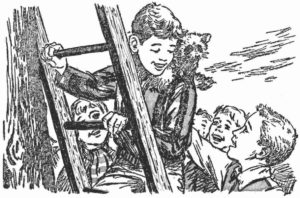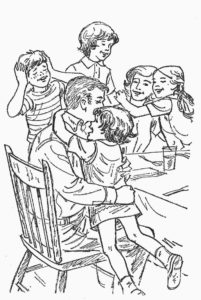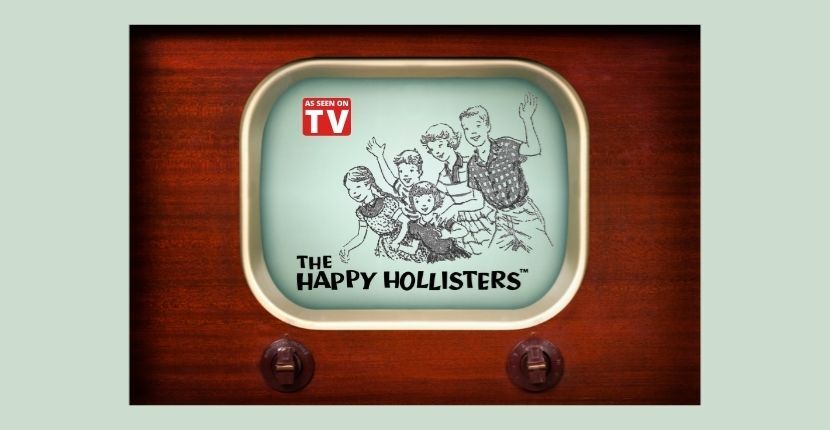Wholesome. Tight knit. Child-centric. These are characteristics that could be used to describe the Hollister family in The Happy Hollisters book series by Jerry West as well as many fictional television families of the 1950s and 1960s. From Leave It To Beaver to The Andy Griffith Show, TV shows from this era painted an idealistic picture of the suburban American family and captured the often-stereotypical characteristics of many mid-century families.
How Many Kids?!
 Family sizes have changed throughout the years, due to social and economic factors, but in the 1950s and 1960s, the nuclear family was the norm. The typical nuclear family included married parents and at least two or three children. Families with multiple children, like the Hollister parents and their five kids, were not uncommon, and Happy Hollisters author Andrew Svenson, writing under the pseudonym Jerry West, was even inspired by his own large family, which actually included six children.
Family sizes have changed throughout the years, due to social and economic factors, but in the 1950s and 1960s, the nuclear family was the norm. The typical nuclear family included married parents and at least two or three children. Families with multiple children, like the Hollister parents and their five kids, were not uncommon, and Happy Hollisters author Andrew Svenson, writing under the pseudonym Jerry West, was even inspired by his own large family, which actually included six children.
Many TV shows of this time were very focused on the family and featured families with two or more children, like Leave It to Beaver, Father Knows Best, and even The Addams Family. Shows like these paved the way for future shows centered around larger families, like The Brady Bunch and Full House which also introduced twists on the typical two-parent family theme. One of the most extreme examples of the large American family is the original Cheaper by the Dozen film, released in 1950, about a family with twelve children.
Cookies and Care from Mom . . .
While Elaine Hollister, the mother of Pete, Pam, Ricky, Holly, and Sue, is involved in many of her children’s adventures, she is more often found in the kitchen making a delicious family meal, cleaning the house, or gardening. She fits the mold of the typical mother of the time, whose primary concerns were home and family. Most women of this time period were housewives without jobs outside of the home who were instead devoted to the happiness and wellbeing of their children and husbands.
One of the most iconic fictional mothers of this era is June Cleaver from Leave It To Beaver. In the show, she is typically found whipping up meals in her pristine kitchen or hosting luncheons for the neighbor ladies, always dressed in a crisply ironed frock, frilly apron, and a strand of pearls. While luncheons and pearls might not be the goals of the modern woman, simply being a put-together, doting mother like Elaine Hollister or June Cleaver was the aspiration for many women in the 1950s.
. . . and Discipline and Values from Dad
Fathers, on the other hand, were not expected to play an active role in raising their families. Men worked outside the home, like John Hollister at his Trading Post store, and served as the breadwinner of the family so that their wives could remain at home. Fathers were traditionally less involved in the daily details of their children’s lives but were called upon to provide discipline and guidance when a firmer hand was required.
Two notable examples of fatherhood in the 1950s and 1960s are Jim Anderson from Father Knows Best and Andy Taylor from The Andy Griffith Show. Both fathers often wind up teaching their children valuable lessons, on everything from standing up to bullies to the importance of making their own money. Though both these fathers worked outside the home, as an insurance agent and police office, respectively, they still always find the time to teach lessons and impart their own folksy wisdom to their children.
Free Rein and Open Doors
Throughout The Happy Hollisters series, the sleuthing siblings spend a lot of time playing outside and solving mysteries around their small town of Shoreham. To modern parents, it might seem strange to let their children run free throughout the day before returning home for supper, but letting kids play without intense supervision was a common parenting approach in those days. Children were often allowed to play outside or ride their bikes around town without parental supervision until the streetlights came on, and doors were frequently left unlocked to let adventurous kids return home for a break or a snack.
In Leave It to Beaver, the titular Beaver and his brother often spend their days outside, riding their bikes around town, hanging out with friends, or much to the chagrin of their elegant mother, bringing home various animals. Similarly, Opie in The Andy Griffith Show is often left to his own devices and frequently gets into mischievous situations, much like Ricky Hollister.
With a stay-at-home mother and a working father who both teach many important lessons and multiple kids who roam freely around Shoreham, the Hollister family fits right in with many television families of the 1950s and 1960s.
Who is your favorite fictional family from this time period?
by Libby Svenson Kennedy
Sources:
Research notes, Andrew Svenson Archives of The Hollister Family Properties Trust
https://family.lovetoknow.com/about-family-values/1950s-family-structure-values-everyday-life
https://www.dailydoowop.com/classic-tv-shows-and-the-american-family/

